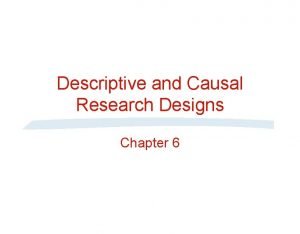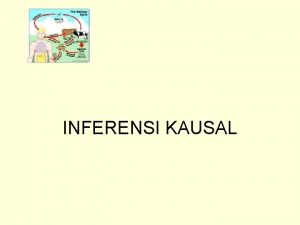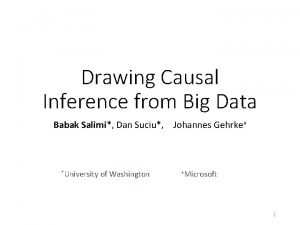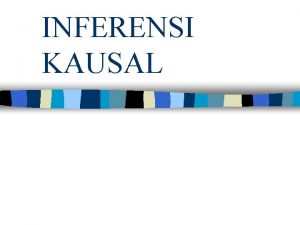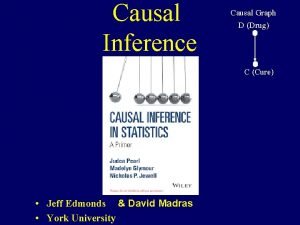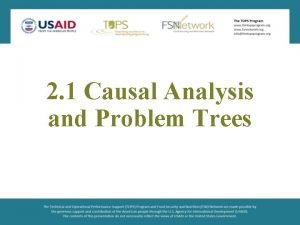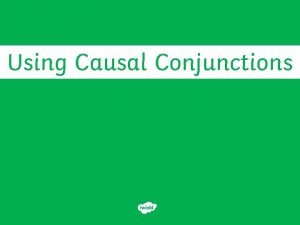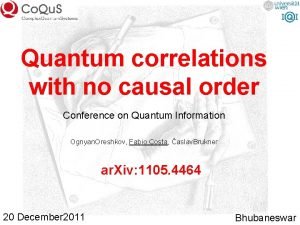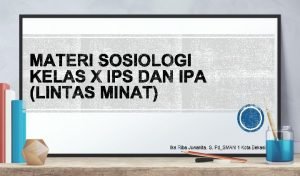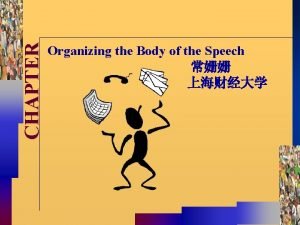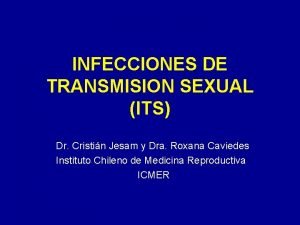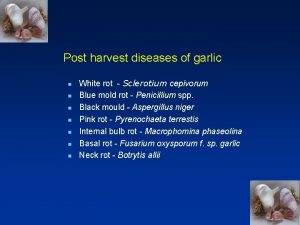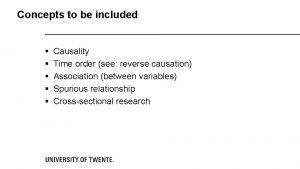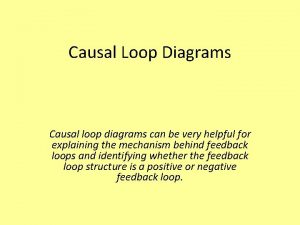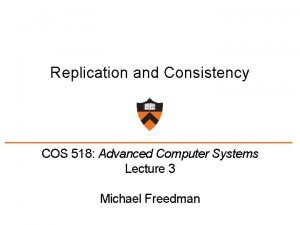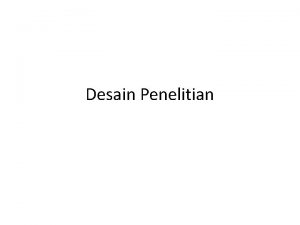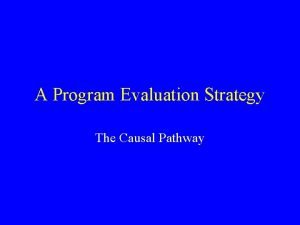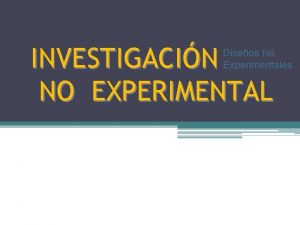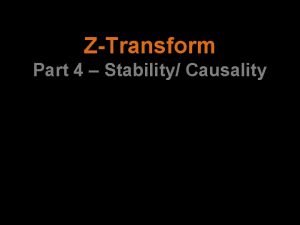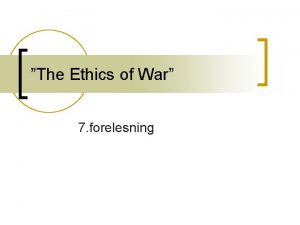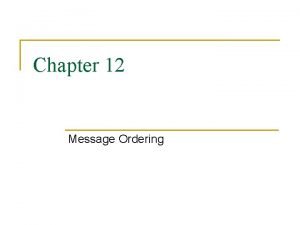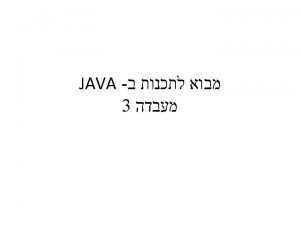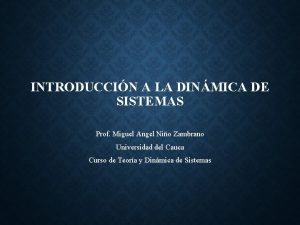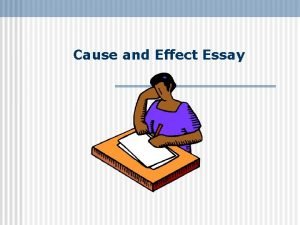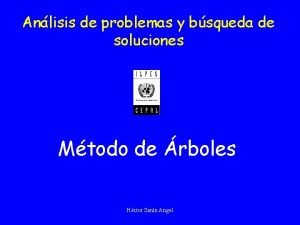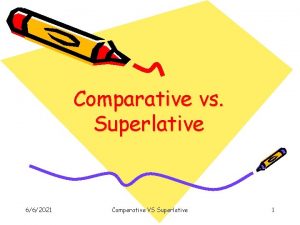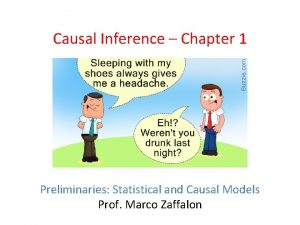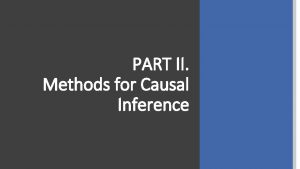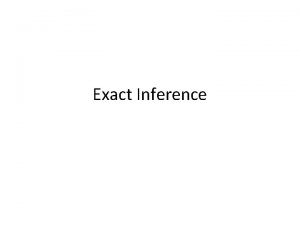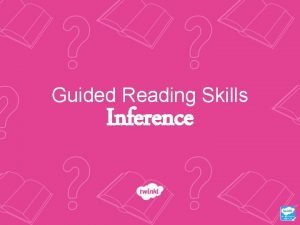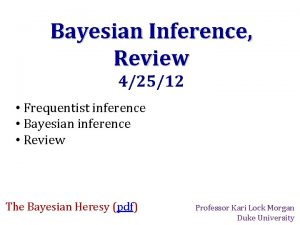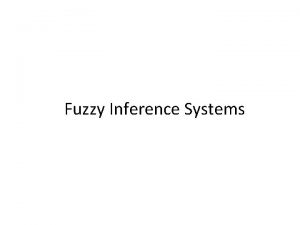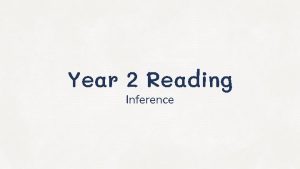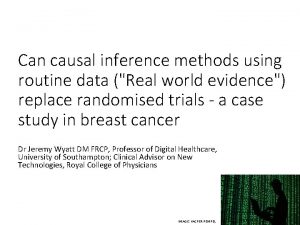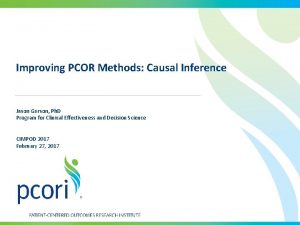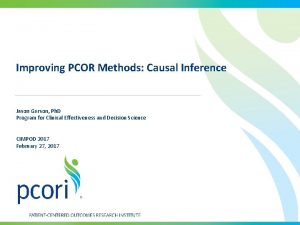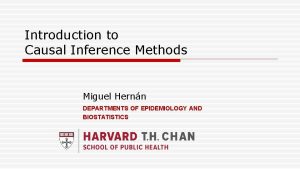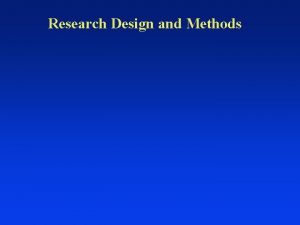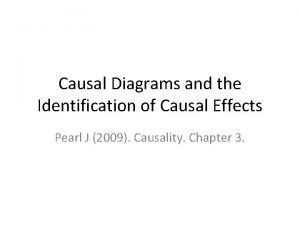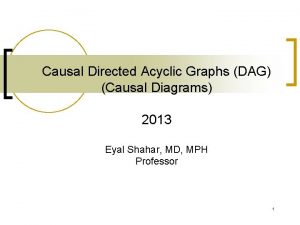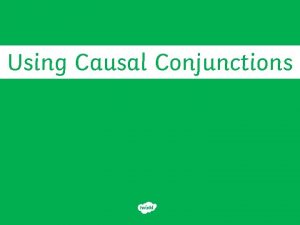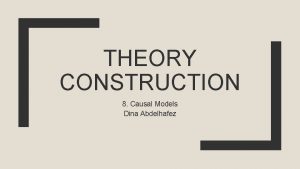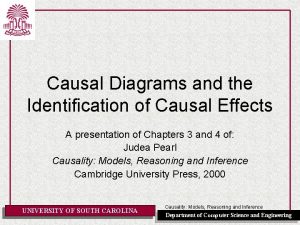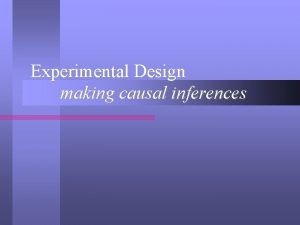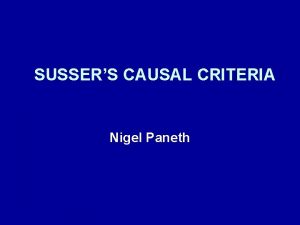PART II Methods for Causal Inference PART II













































































































- Slides: 109

PART II. Methods for Causal Inference

PART II. Methods for Causal Inference Observational Studies Natural Experiments Refutations

Review: Treatment, Outcome and Confound X • T Y X T Y

Review: Treatment, Outcome and Confound X • T Y X T Y

g n i n n u R Review: Exercise, Cholesterol, and Age e l p exam • Age Exercise Cholesterol

g n i n n u R Review: Exercise, Cholesterol, and Age e l p exam • Age B n n a c e w f i ut, what ? e n e v r e t Exercise n i y l e v i t c ot a Cholesterol

Part II. A. Observational Studies “Simulating randomized experiments" Conditioning on Key Variables Matching and Stratification Weighting Regression Doubly Robust Synthetic Controls

Part II. A. Observational Studies “Simulating randomized experiments" Conditioning on Key Variables Matching and Stratification Weighting Regression Doubly Robust Synthetic Controls

Cholesterol Stationary Biking

Cholesterol Stationary Biking

Age 40 Cholesterol 35 30 25 20 Stationary Biking

Age 40 Cholesterol 35 30 25 20 Stationary Biking

Recapping what just happened • At first, more stationary biking seems to lead to higher cholesterol • But, we realize that there is a confounder, age, that influences both stationary biking and cholesterol • We condition on age (by analyzing each age group separately) • And find stationary biking now seems to lead to lower cholesterol

What are the assumptions we made? • Assumption: age is the only confounder • “Ignorability” or “selection on observables” assumption • How do we know what we must condition on? • Assumption: effect of stationary biking doesn’t depend on friends’ exercise • Stable Unit Treatment Value (SUTVA) assumption • Are there network effects? • Assumption: our observations of exercise/no-exercise cover similar people • “Common support” or “Overlap” assumption • Also: data is not covering all combinations of age and levels of exercise • Will our lessons generalize beyond the observed region?

A 1: Ignorability •

A 2. Stable Unit Treatment Value • er b m e r / ow n k e r e h e l p Do peo is? e n i h c a m x what a fa

A 3. Common support •

Advanced: How to know we have the right variables? Backdoor criterion 1. Use domain knowledge to build a model of the causal graph 2. Condition on enough variables to cover all backdoor paths Occupation Income Diet Age Exercise Cholesterol Caveat: Causal effect only if assumed graphical model is correct 18

What we just learned: Simple Conditioning Definition Conditioning calculates treatment effects by identifying groups of individuals with the same covariates, where individuals in one group are treated and in the other group are not. Intuition Example In the cartoon relationship between exercise and cholesterol, age is a confounder, as it influences both levels of exercise and cholesterol. By conditioning analysis on age, we can identify the effect of exercise. Keep in mind

Part II. A. Observational Studies “Simulating randomized experiments" Conditioning on Key Variables Matching and Stratification Weighting Simple Regression Doubly Robust Synthetic Controls

Avg Cholesterol = 200 Avg Cholesterol = 206


Matching • i : j

Exact Match •

Mahalanobis Distance •

Propensity Score •

How to match with propensity score •

Propensity score, FAQ Q: Wait, why does this work? A: Individuals with similar covariates get similar scores, and all individuals mapped to a similar score have similar treatment likelihoods. Q: What if my propensity score is not accurate? (i. e. , can’t tell who is treated) A: That’s ok. The role of the model is to balance covariates given a score; not to actually identify treated and untreated. Q: What if my propensity score is very accurate? (i. e. , can tell who is treated) A: Means we cannot disentangle covariates from treatment status. Any effect we observe could be due either to the treatment or to the correlated covariate. Consider redefining the treatment or general problem statement. Don’t dumb down model!

Propensity score matching python code # learn propensity score model psmodel = linear_model. Linear. Regression() psmodel. fit(covariates, treatment_status) data['ps'] = psmodel. predict(covariates) # find nearest neighbor matches control. Matcher = Nearest. Neighbors(). fit(untreated['ps’]) distances, match. Index = control. Match. kneighbors(treated['ps']) # iterate over matched pairs and sum difference in outcomes for i in range(numtreatedunits): treated_outcome = treated. iloc[i][outcome_name]. item() untreated_outcome = untreated. iloc[match. Index[i]][outcome_name]. item() att += treated_outcome - untreated_outcome # normalize att /= numtreatedunits

Advanced: Matching • When matching, should we allow replacement? • It’s a bias / variance trade-off • When matching, what if nearest neighbor is far away? • Use a caliper threshold to limit acceptable distance • What if not all treated individuals are matched to untreated? • This will bias results. Consider redefining original cohort / population to cleanly exclude treated who won’t have matches in untreated population. • Treatment should be a binary point treatment • Advanced variants allow multi-dose, and other treatment regimens

What we just learned: Matching Definition Matching calculates treatment effects by identifying pairs of similar individuals, where one is treated and the other is not. Intuition The paired individuals stand-in as the counterfactual observations for one another. Example In our cartoon, we create pairs of individuals matched exactly on their age. More generally, we can use Mahalanobis distance or propensity score matching to find similar individuals to be matched. Keep in mind Matching calculates the treatment effect on the treated population. We do not know what might happen if people who would never get treatment are suddenly treated.


180 200 190 240 230

From Matching to Stratification •

How to stratify with propensity score •

Propensity Score Stratification We can use propensity score to stratify populations 1. Calculate propensity scores per individual as in matching. 2. But instead of matching, stratify based on score. 3. Calculate average treatment effect as weighted average of outcome differences per strata. 4. Weight by number of treated in the population for ATE on treated. Propensity = 0. 0 Propensity = 1. 0

Propensity Score Stratification • Propensity = 0. 0 Propensity = 1. 0

Propensity score stratification python code # build propensity score model and assign each item a score as earlier… # create a column 'strata' for each element that marks what strata it belongs to data['strata'] = ((data['ps']. rank(ascending=True) / numrows) * num. Strata). round(0) data['T_y'] = data['T'] * data['outcome’] # T_y = outcome iff treated data['Tbar'] = 1 - data['treated’] # Tbar = 1 iff untreated data['Tbar_y'] = data['Tbar'] * data['outcome'] # Tbar_y = outcome iff untreated stratified = data. groupby('strata') # sum weighted outcomes over all strata (weight by treated population) outcomes = stratified. agg({'T': ['sum'], 'Tbar': ['sum'], 'T_y': ['sum'], 'Tbar_y': ['sum']}) # calculate per-strata effect outcomes[‘T_y_mean'] = outcomes[‘T_y_sum'] / outcomes['T'] outcomes[‘Tbar_y_mean'] = outcomes[‘Tbar_y_sum'] / outcomes['dbar_sum'] outcomes['effect'] = outcomes[‘T_y_mean'] - outcomes[‘Tbar_y_mean’] # weighted sum of effects over all strata att = (outcomes['effect'] * outcomes['T']). sum() / totaltreatmentpopulation

P. S. Stratification, Practical Considerations • How many strata do we pick? • • • Scale will depend on data. Want each stratum to have enough data in it. Conventional, small-data literature (e. g. , ~100 data points) picked 5. With 10 k to 1 M or more data points, I pick 100 to 1000 strata. Set strata boundaries to split observed population evenly Aside: why not always pick a small number of strata? It’s a bias-variance trade -off… • What if there aren’t enough treated or untreated individuals in some of my stratum to make a meaningful comparison? • This often happens near propensity score 0. 0 and near 1. 0 • Drop (“Clip”) these strata from analysis. Technically, you are now calculating a local-average-treatment-effect.

What we just learned: Stratification Definition Stratification calculates treatment effects by identifying groups of individuals with similar distributions of covariates, where individuals in one group are treated and in the other group are not. Intuition The difference in average outcome of paired groups tells us the effect of the treatment on that subpopulation. Observed confounds are balanced, due to covariate similarity across paired groups. Example In our cartoon example, we stratified based on propensity score into 3 strata. ATE is the weighted sum of differences in avg outcomes in each strata. Keep in mind Make sure there are enough comparable individuals in each strata

Part II. A. Observational Studies “Simulating randomized experiments" Conditioning on Key Variables Matching and Stratification Weighting Simple Regression Doubly Robust Synthetic Controls

Weighting: An alternative to conditioning What if we assign weights to observations to simulate randomized experiment? Stratification weights strata results by number of treated Weighting by treated population ~ weighting by propensity score. Generalized weighting: Calculate effect by weighted sum over all individual outcomes Many weighting methods to generate a balanced dataset Propensity = 0. 0 Propensity = 1. 0

Weighting Stratification weights strata results by number of treated Weighting by treated population ~ weighting by propensity score. Generalized weighting: Calculate effect by weighted sum over all individual outcomes Many weighting methods to generate a balanced dataset Propensity = 0. 0 Propensity = 1. 0

Weighting •

Weighting: Caveats and Practical notes • 45

What we just learned: Weighting Definition Weighting calculates average treatment effect as the difference between the weighted sum of the treated and untreated populations Intuition Weights on each individual act to balance the distribution of covariates in the treated and untreated groups. (i. e. , break the dependence between treatment status and covariates) Keep in mind High variance when propensity scores are very high or very low Many variants of weighting schemes

Part II. A. Observational Studies “Simulating randomized experiments” Conditioning on Key Variables Matching and Stratification Weighting Simple Regression Doubly Robust Synthetic Controls

Regression (or supervised learning) •

Regression warnings Causal interpretation of regressions requires many assumptions. Threats to validity include: - Model correctness: e. g. , what if we use a linear model and causal relationship is non-linear - Multicollinearity: if covariates are correlated, can’t get accurate coefficients - Ignorability (Omitted variables): Omission of confounds will invalidate findings

What we just learned: Regression Definition Use a regression-based causal analysis, we interpret coefficients as the strength of causal relationship Example Modeling cholesterol as a function of exercise and age Keep in mind Analysis must be carefully designed to ensure causal interpretability, avoiding collinearity and including all relevant confounds Avoid unless you are absolutely sure of what you are doing.

Part II. A. Observational Studies “Simulating randomized experiments" Conditioning on Key Variables Matching and Stratification Weighting Simple Regression Doubly Robust Synthetic Controls

Doubly robust: Best of both worlds? • Both propensity score weighting and regression models require correctly specified models • E. g. , if propensity score or regression is modeled as a linear combination, but is non-linear, than it is not correctly specified • Doubly robust methods combine “best of” propensity score and regression methods • If either propensity score or regression is correctly specified, then doubly robust is correct.

DR: Combines 3 components •

Doubly Robust: Caveat If either propensity score or regression is correctly specified, then doubly robust is unbiased. Seems like doubly robust should be strictly better (less biased) than either propensity score weighting or regression But, if both propensity score or regression are slightly incorrect, then doubly robust estimator may become very biased

What we just learned: Doubly Robust Intuition Combine propensity score weighting and regression models to provide unbiased estimate when either propensity score or regression is correctly specified Keep in mind Fundamental assumptions (ignorability, etc) must still hold. If both models are slightly incorrect, doubly robust estimator can be more biased

Part II. A. Observational Studies “Simulating randomized experiments" Conditioning on Key Variables Matching and Stratification Weighting Simple Regression Doubly Robust Synthetic Controls

Synthetic control •

Synthetic controls: Intuition 1. Decide what the treatment will be 2. Pre-treatment stage: Observe the world for a while • Record the outcome we care • Record covariates that can help us predict our observed outcome, but will not be effected by the treatment. Use domain-knowledge / theory to identify these covariates. • Learn a model that predicts outcome based on covariates. 3. Post-treatment stage: • Keep recording outcome. This is now the treated outcome. • Predict untreated outcome using learned model and current covariates • ATE = Difference between observed outcome and prediction of untreated outcome

Example: policy change to encourage exercise Build model of cholesterol from pre-treatment data Age, Restaurants, Vegetable Prices, … Time Cholesterol Time Synthetic control (untreated) predicted from covariates Treatment effect is the difference between predicted control and observed (treated) outcome

What we just learned: Synthetic Controls Definition Calculate treatment effect by comparing observed outcomes of treated population with synthetic (predicted) outcomes of an untreated population Intuition If we can measure covariates that are unaffected by the treatment and predictive of untreated outcomes, then we can build a synthetic control Example Predicting effect of global policy change to encourage exercise on population-wide cholesterol Keep in mind Ignorability assumption must still hold; Relatedly, be concerned about generalizability/robustness of learned outcome model

PART II. Methods for Causal Inference Observational Studies Natural Experiments Refutations

Part II. B. Natural Experiments Simple natural experiment Instrumental Variables Regression Discontinuities

Natural experiments: What can we do without ignorability? Rather than assume ignorability over the entire dataset, find data subsets that approximate an experiment. “Natural” as if Nature conducted an experiment for you Common sources: Prior A/B tests, Lottery, any randomized policy, an external shock to the treatment. Allows common causes of T and Y, as long as the source is not affected by them.

Finding a natural experiment Example: Cholera cause estimation in 1850 s.

1854: London was having a devastating cholera outbreak 65

Enter John Snow. He found higher cholera deaths near a water pump, but could be just correlational. 66

V S & TER WA PANY COM H ET MB LA TER NY WA MPA CO New Idea: Two major water companies for London: one upstream and one downstream. Customers of each company distributed throughout city 67

S&V and Lambeth No difference in neighborhood, still an 8 -fold increase in cholera with the downstream company. 68

“Natural” experiments: exploit variation in observed data Dunning (2002), Rosenzweig-Wolpin (2000) 69

What we just learned: Simple natural experiment Definition Exploit “as-if random” assignment of treatments to measure outcome. Intuition When assignment of treatment is unrelated to the measured outcome and their common causes, we can treat it as if it is a randomized experiment to estimate treatment effect. Example What water company do you buy from? Keep in mind As-if random assignments of treatments are hard to find. Estimates very sensitive to violation of exclusion assumption.

As-if Random Part II. B. Natural Experiments Instrumental Variables Regression Discontinuities

Prior setup can be generalized as search for an “instrumental variable” Other factors [e. g. neighborhood] (U) As-If-Random Water Company( Z) Contaminated Water (T) Exclusion Cholera Diagnosis (Y)

Prior setup can be generalized as search for an “instrumental variable” As-If-Random Unobserved Confounders (U) Instrument (Z) Cause (X) Outcome (Y) Exclusion 73

Intuition: Can use this variation to compute causal effect 74

A generalized natural experiment: Instrumental Variables 75

Example: Effect of store recommendations 76

Traffic on normal days to App 1 77

External shock brings as-if random users to App 1 78

Exploiting sudden variation in traffic to App 1 79

Automatically Identifying Natural Experiments Split-Door Criterion • Finds 7, 000 natural experiments, instead of 133 • Result: Across 10 product categories, half of recommendation clicks would have happened anyway Sharma et al. Split-door criterion for causal identification: Automatic search for natural experiments, 2016

81

But there are so many natural variations. 82

83

What we just learned: Instrumental Variables Definition Instrumental variables (IV) introduce “as-if random” noise into treatment assignment, and are used to estimate treatment effect Intuition Examples Encouraging people to exercise at random. Sudden increase in page visits to a product. Keep in Mind Causal Estimate may not generalize to full population. Estimate very sensitive to the violations of IV assumptions.

As-if Random Part II. B. Natural Experiments Instrumental Variables Regression Discontinuities

Regression discontinuities: Look for arbitrary changes to treatment Instead of an IV changing the distribution of treatment over individuals, an arbitrary change decides the treatment deterministically. At time t, a cholesterol drug A is banned, and people switch to another drug B. What was the relative effect of drug A over B ? Cholesterol Due to selection effects, people taking drug A are different from those taking drug B. A Time But within [t-1, t+1] duration, patients of A and B can be assumed to be similar.

Regression discontinuities Cholesterol Below income threshold t, free health insurance. What is effect of health insurance on cholesterol? Due to selection effects, people with health insurance different from those without. Household Income But within [t-1, t+1] income, people with or without health insurance are similar.

Regression discontinuities also depend on asif-random and exclusion As-if-random: People near the threshold are similar to each other, as if Nature randomized them on either side of the threshold. Exclusion: Merely being on one side of the threshold does not affect the outcome. Very common: Many decisions in organizations, arbitrary decisions in software examples. Can be thought of as a special case of an instrumental variable.

Example: Effect of Store recommendations 89

Exploiting arbitrary cutoffs to recommendations 90

Assumption: Closely-ranked not-shown apps are as relevant as shown apps 91

Algorithm: Regression discontinuity 92

What we just learned: Regression Discontinuities Definition Regression discontinuities identify arbitrary boundaries between treated and untreated populations, measure treatment effect as difference in outcomes at the boundary Intuition Example Policy decisions based on income or time; exogenous shocks; and are all common sources of regression discontinuities Keep in mind Only estimates treatment effect at the boundary. Effect may vary elsewhere!

PART II. Methods for Causal Inference Observational Studies Natural Experiments Refutations

Causal inference is only possible with assumptions 95

(Step 1): Making explicit the difference between identification and estimation Why do observational studies fail? Most likely due to errors in identification. --Estimation is a statistical problem, relatively easy. 96

(Step 2): Explicitly represent your identifying and estimating assumptions. Identifying assumption: All the arrows missing in the causal graphical model. E. g. No other common cause exists -> Untestable in general. Estimating assumption: Overlap between treated and untreated population. Can be solved by collecting more data. 97

(Step 3): Refute your assumptions, and analyze your estimate’s sensitivity to violations Identifying assumption: All the arrows missing in the causal graphical model. E. g. No other common cause exists -> Untestable in general. -- What happens when another common cause exists? -- What happens when treatment is placebo? 98

To make these steps easy, we created Do. Why: a python library for causal inference Do. Why focuses attention on the assumptions required for causal inference. Provides estimation methods such as matching and IV so that you can focus on the identifying assumptions. -- Models assumptions explicitly using causal graphical model. -- Provides an easy way to test them (if possible) or analyze sensitivity to violations. Unifies all methods to yield four verbs for causal inference: -- Model -- Identify -- Estimate -- Refute 99

Do. Why: Sample causal inference analysis in 4 lines 100

Refutation 1: Add random variables to your model 101

Refutation check 2: Replace treatment by a placebo (A/A test) 102

Refutation Check 3: Divide data into subsets (cross-validation) 103

Refutation Check 4: Test Balance of Covariates 104

When refutations are not possible? Sensitivity Analysis to violations of assumptions

Example: Does smoking cause lung cancer? Demographics Smoking Genes Lung Cancer 106

Observational causal inference: Best practices 107

Try out Do. Why to see best practices in action Do. Why: A Python Library for Causal Inference Principled: Converts prior knowledge to a formal causal graph Simple: Automated analysis of many assumptions, one line of code for powerful causal inference algorithms Robust: Battery of tests to refute obtained estimates Modest: No estimate if the data is insufficient • Input: Observational data, Causal graph • Output: Causal effect between desired variables, “What-if” analysis Code: https: //github. com/Microsoft/dowhy Docs: http: //causalinference. gitlab. io/dowhy 108

PART I. Introduction to Counterfactual Reasoning PART II. Methods for Causal Inference PART III. Large-scale and Network Data PART IV. Broader Landscape
 Exploratory, descriptive and causal research
Exploratory, descriptive and causal research Inferensi kausal adalah
Inferensi kausal adalah Babak salimi
Babak salimi Causal inference techniques
Causal inference techniques Causal inference vs correlation
Causal inference vs correlation Wax pattern in fpd
Wax pattern in fpd Atmosfr
Atmosfr Standardavvikelse formel
Standardavvikelse formel Personlig tidbok
Personlig tidbok Rutin för avvikelsehantering
Rutin för avvikelsehantering Biologiska arvet
Biologiska arvet Presentera för publik crossboss
Presentera för publik crossboss Fspos vägledning för kontinuitetshantering
Fspos vägledning för kontinuitetshantering Myndigheten för delaktighet
Myndigheten för delaktighet Att skriva debattartikel
Att skriva debattartikel Var 1721 för stormaktssverige
Var 1721 för stormaktssverige Tobinskatten för och nackdelar
Tobinskatten för och nackdelar Referatmarkering
Referatmarkering Byggprocessen steg för steg
Byggprocessen steg för steg Sten karttecken
Sten karttecken Epiteltyper
Epiteltyper Varför kallas perioden 1918-1939 för mellankrigstiden?
Varför kallas perioden 1918-1939 för mellankrigstiden? Rbk mätning
Rbk mätning Vätsketryck formel
Vätsketryck formel Vad är densitet
Vad är densitet Elektronik för barn
Elektronik för barn Borra hål för knoppar
Borra hål för knoppar Tack för att ni har lyssnat
Tack för att ni har lyssnat Anatomi organ reproduksi
Anatomi organ reproduksi Smärtskolan kunskap för livet
Smärtskolan kunskap för livet Bris för vuxna
Bris för vuxna Argument för teckenspråk som minoritetsspråk
Argument för teckenspråk som minoritetsspråk Novell typiska drag
Novell typiska drag Frgar
Frgar Autokratiskt ledarskap
Autokratiskt ledarskap Humanitr
Humanitr Uppställning multiplikation
Uppställning multiplikation Toppslätskivling dos
Toppslätskivling dos Redogör för vad psykologi är
Redogör för vad psykologi är En lathund för arbete med kontinuitetshantering
En lathund för arbete med kontinuitetshantering Bra mat för unga idrottare
Bra mat för unga idrottare Geometriska former i förskolan
Geometriska former i förskolan Etik och ledarskap etisk kod för chefer
Etik och ledarskap etisk kod för chefer Publik sektor
Publik sektor Klädsel i rom
Klädsel i rom Datorkunskap för nybörjare
Datorkunskap för nybörjare Rita perspektiv
Rita perspektiv Orubbliga rättigheter
Orubbliga rättigheter Ministerstyre för och nackdelar
Ministerstyre för och nackdelar Tillitsbaserad ledning
Tillitsbaserad ledning Bat mitza
Bat mitza Nationell inriktning för artificiell intelligens
Nationell inriktning för artificiell intelligens Bästa kameran för astrofoto
Bästa kameran för astrofoto Klassens tjejtjusare rim
Klassens tjejtjusare rim Nyckelkompetenser för livslångt lärande
Nyckelkompetenser för livslångt lärande Romarriket tidslinje
Romarriket tidslinje Handledning reflektionsmodellen
Handledning reflektionsmodellen Stål för stötfångarsystem
Stål för stötfångarsystem Bamse för de yngsta
Bamse för de yngsta Underlag för särskild löneskatt på pensionskostnader
Underlag för särskild löneskatt på pensionskostnader Verktyg för automatisering av utbetalningar
Verktyg för automatisering av utbetalningar Vishnuismen
Vishnuismen Exspektans eller expektans
Exspektans eller expektans Jag har nigit för nymånens skära text
Jag har nigit för nymånens skära text Strategi för svensk viltförvaltning
Strategi för svensk viltförvaltning Boverket ka
Boverket ka Verksamhetsanalys exempel
Verksamhetsanalys exempel Tack för att ni har lyssnat
Tack för att ni har lyssnat Läkarutlåtande för livränta
Läkarutlåtande för livränta Klassificeringsstruktur för kommunala verksamheter
Klassificeringsstruktur för kommunala verksamheter Vad står k.r.å.k.a.n för
Vad står k.r.å.k.a.n för Centrum för kunskap och säkerhet
Centrum för kunskap och säkerhet Inköpsprocessen steg för steg
Inköpsprocessen steg för steg Påbyggnader för flakfordon
Påbyggnader för flakfordon Tack för att ni lyssnade
Tack för att ni lyssnade Egg för emanuel
Egg för emanuel Dolo causante vs dolo incidente
Dolo causante vs dolo incidente Causal analysis and resolution examples
Causal analysis and resolution examples Sentences with causal conjunctions
Sentences with causal conjunctions Quantum correlations with no causal order
Quantum correlations with no causal order Ciri ciri storming
Ciri ciri storming Causal order speech example
Causal order speech example Tasa urofecal
Tasa urofecal Recall bias example
Recall bias example Causal organism of neck and bulb rot in garlic is _____
Causal organism of neck and bulb rot in garlic is _____ Causal time order
Causal time order Microorganismo causal
Microorganismo causal Avoiding discrimination through causal reasoning
Avoiding discrimination through causal reasoning Ciro stratus
Ciro stratus Casual consistency
Casual consistency Causal research adalah
Causal research adalah Causal pathway framework
Causal pathway framework Diseños transeccionales exploratorios
Diseños transeccionales exploratorios Causality and stability in laplace transform
Causality and stability in laplace transform Causal responsibility vs moral responsibility
Causal responsibility vs moral responsibility Causal ordering of messages
Causal ordering of messages Uml while loop
Uml while loop Diagrama forrester
Diagrama forrester Conclusive vs exploratory research
Conclusive vs exploratory research Robert marzano's causal teacher evaluation model
Robert marzano's causal teacher evaluation model Causal agent of tobacco mosaic virus
Causal agent of tobacco mosaic virus Chain structure essay
Chain structure essay Research methodology secondary data example
Research methodology secondary data example Encadenamiento causal
Encadenamiento causal Nexos subordinadas adverbiales
Nexos subordinadas adverbiales Noisy superlative
Noisy superlative Tipos de hilos de sutura pdf
Tipos de hilos de sutura pdf Discuss descriptive and casual research designs
Discuss descriptive and casual research designs What is causal attribution theory
What is causal attribution theory Professor eyal shahar
Professor eyal shahar
